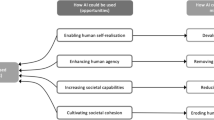Abstract
The goal of responsible engineers is the creation of useful and safe technological products and commitment to public health, while respecting the autonomy of the clients and the public. Because engineers often face moral dilemma to resolve such issues, different engineers have chosen different course of actions depending on their respective moral value orientations. Islam provides a value-based mechanism rooted in the Maqasid al-Shari‘ah (the objectives of Islamic law). This mechanism prioritizes some values over others and could help resolve the moral dilemmas faced in engineering. This paper introduces the Islamic interpretive-evaluative maxims to two core issues in engineering ethics: genetically modified foods and whistleblowing. The study aims primarily to provide problem-solving maxims within the Maqasid al-Shari‘ah matrix through which such moral dilemmas in science and engineering could be studied and resolved.
Similar content being viewed by others
Notes
To render halal as ‘not unlawful’ or ‘not prohibited’ is based on the Islamic legal maxim that things are originally permissible (for use, consumption etc.) as long as there is no evidence to prohibit them.
References
Abdullah, M. F. (2004). Professionalism: The Islamic perspective. Jurutera: The Monthly Bulletin of the Institution of Engineers, Malaysia, Bil. 2003, No. 2, 9–11.
Abu Dawud, S. (1995). Sunan Abi Dawud, kitab al-adab: Book of general behavior. Beirut: Al-Maktabah al-‘Asriyyah.
Al-Amidi, S. (1985). Al-ihkam fi usul al-ahkam. Beirut: Dar al-Kutub al-‘Arabiyyah.
Al-Faruqi, I. R. (1967). Christian ethics. Montreal: McGill University Press.
Al-Ghazali, A. (1993). Al-mustasfa fi ‘ilm al-usul. Beirut: Dar al-Kutub al-‘Ilmiyyah.
Al-Raysuni, A. (2006). Imam al-Shatibi’s theory of the higher objectives and intents of Islamic law. Herndon: International Institute of Islamic Thought.
Al-Zuhayli, W. (1997). Al-fiqh al-Islami wa-adillatuh. Damascus: Dar al-Fikr al-Mu’asir.
Bagby, I. A. (1986). Utility in classical Islamic law: The concept of ‘Maslahah’ in “Usul al-Fiqh”. Ann Arbor, MI: University of Michigan Press.
Beekun, R. I. (1997). Islamic business ethics. Herndon, VA: International Institute of Islamic Thought.
Bowie, N. (1982). Business ethics. Englewood Cliffs, NJ: Prentice Hall.
Buckle, H. T. (1959). History and operation of universal laws. In P. Gardiner (Ed.), Theories of history (pp. 105–124). New York: The Free Press.
Coates, G. (2000). Developing a values-based code of engineering ethics. IPENZ Transactions, 27(1), 11–16. Accessed September 17, 2009 from http://www.ipenz.org.nz/ipenz/publications/transactions/Transactions2000/General/2coates.pdf.
Comstock, G. (2000). Vexing nature? On the ethical case against agricultural biotechnology. Boston: Kluwer.
Firmage, D. A. (1991). The definition of a profession. In D. G. Johnson (Ed.), Ethical issues in engineering (pp. 63–66). New Jersey: Prentice Hall.
Fleddermann, C. B. (1999). Engineering ethics. New Jersey: Prentice-Hall Inc.
Fletcher, J. (1988). The ethics of genetic control: Ending reproductive roulette. New York: Prometheus Books.
Florman, S. C. (1976). The existential pleasures of engineering. New York: St. Martin’s Press.
Harris, C. E., Jr. (2008). The good engineer: Giving virtue its due in engineering ethics. Science and Engineering Ethics, 14, 153–164.
Harris, C. E., Jr., Pritchard, M. S., & Rabins, M. J. (1995). Engineering ethics: Concepts and cases. Belmont, CA: Wadsworth Publishing Company.
Humphreys, K. K. (1999). What every engineer should know about ethics. New York: Marcel Dekker.
Ibn Kathir, I. (2002). Tafsir al-Qur’an al-’azim. Cairo: Dar al-Hadith.
Imam al-Nawawi, A. (1994). Riyad al-salihin. Beirut: Dar al-Bayariq.
Imam Muslim. (1978). Sahih Muslim (A. H. Siddiqi, Trans.). New Delhi: Kitab Bhavan.
James, J. E. (2009). Genetic engineering: A “potential” emerging coverage issue? Retrieved September 17, 2009, from http://www.pacdelaware.com/news-publications-0-103.html.
Kamali, M. H. (2000). Principles of Islamic jurisprudence. Selangor, Malaysia: Ilmiah Publishers.
Kroes, P., Light, A., Moore, S. A., & Vermaas, P. E. (2008). Design in engineering and architecture: Towards an integrated philosophical understanding. In P. E. Vermaas, et al. (Eds.), Philosophy and design: From engineering to architecture (pp. 1–17). The Netherlands: Springer.
Martin, M. W., & Schinzinger, R. (1996). Ethics in engineering. New York: McGraw-Hill.
Midgley, M. (2000). Biotechnology and monstrosity: Why we should pay attention to the ‘yuk factor’. Hastings Center Report, 30(5), 7–15.
Ng, J. (2003–2004). Engineering ethics. Engineering Management Journal, 13(6), 30–33.
Rifkin, J. (1998). The biotech century: Harnessing the gene and remaking the world. New York: Jeremy P. Tarcher/Putnam.
Sharma, D. (2002). GM-free food aid! ISIS Report, 7 August 2002. Retrieved February 15, 2007, from http://www.i-sis.org.uk/GM-freefoodaid.php.
Smith, M. (2002). Genetic engineering. Retrieved September 17, 2009, from http://www.bucconeer.worldcon.org/contest/2002e_5.htm.
The Islamic Fiqh Academy. (2008). Resolutions and recommendations of the council of the Islamic Fiqh academy 1985–2000. Retrieved from November 25, 2008, from http://www.irtipms.org/OpenSave.asp?pub=73.pdf.
TIME Magazine. Persons of the Year 2002. Retrieved December 4, 2008, from http://www.time.com/time/subscriber/personoftheyear/2002/poyintro.html.
Tokar, B. (Ed.). (2001). Redesigning life: The worldwide challenge to genetic engineering. Montreal: McGill-Queen University Press.
Unger, S. H. (1991). Codes of engineering ethics. In D. G. Johnson (Ed.), Ethical issues in engineering (pp. 105–129). New Jersey: Prentice Hall.
Urban, H. (2007). The 10 commandments of common sense: Wisdom from the scriptures for people of all beliefs. New York: Simon & Schuster.
Author information
Authors and Affiliations
Corresponding author
Rights and permissions
About this article
Cite this article
Solihu, A.K.H., Ambali, A.R. Dissolving the Engineering Moral Dilemmas Within the Islamic Ethico-Legal Praxes. Sci Eng Ethics 17, 133–147 (2011). https://doi.org/10.1007/s11948-009-9185-7
Received:
Accepted:
Published:
Issue Date:
DOI: https://doi.org/10.1007/s11948-009-9185-7




